SOCIOLOGY
PAPER – III
Note : This paper contains seventy five (75) objective type questions of two (2) marks each. All questions are compulsory.
1. Who was concerned, in his methodology, with ‘the way in which people grasp the consciousness of others while they live within their own stream of consciousness’ ?
(1) M. Rogers
(2) Alfred Shutz
(3) J. Duglas
(4) George Ritzer
2. Which one of the following approaches mainly focuses on ‘consciousness’ ?
(1) Ethnomethodology
(2) Comparative method
(3) Phenomenology
(4) Functionalism
3. Who have written the book, ‘The Social Construction of Reality’ ?
(1) T. Luckmann and Reinhardt Bendix
(2) Peter Berger and T. Luckmann
(3) Ruth Benedict and Peter Berger
(4) Reinhardt Bendix and Ruth Benedict
4. Who provides an account of ‘the role of common sense knowledge in the social construction of every day life and institution’ ?
(1) Peter Berger
(2) George Lucas
(3) Max Weber
(4) Erving Goffman
5. Who is said to be the founder of the specialist approach of Ethnomethodology ?
(1) Alfred Shutz
(2) Harold Garfinkel
(3) Erving Goffman
(4) John K. Galbraith
6. Match the List-I with List-II and select the correct answer from the codes given below the lists :

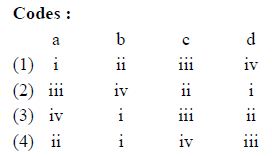
7. According to whom ideology must be seen not merely as ‘false consciousness’ but as an important part of real social relations ?
(1) Habermas
(2) Althusser
(3) Adorno
(4) Giddens
8. Unlike functionalism, neofunctionalism devotes roughly equal attention to which of the following ?
(1) Action and Order
(2) Action and Reaction
(3) Beliefs and Practices
(4) Actor and Situation
9. Which term Althusser has used to convey the idea that major changes in society are complex and multiply ?
(1) Multiplicity
(2) Over determination
(3) Contradiction
(4) Reductionism
10. Who among the following can be classified as a ‘critical theorist’ ?
(1) Alexander
(2) Habermas
(3) Althusser
(4) Bourdieu
11. According to Alexander which one of the following is not the problem associated with structural functionalism that neofunctionalism needs to overcome ?
(1) Anti-individualism
(2) Conservatism
(3) Idealism
(4) Multidimensionalism
12. Who among the following makes use of the concept of ‘communicative action’ in the process of making ‘validity claims’ ?
(1) Turner
(2) Althusser
(3) Habermas
(4) Giddens
13. The concept ‘difference’ used by Derrida refers to two meanings. Which one of the following pairs is true ?
(1) Differ and Prolong
(2) Distance and Closeness
(3) Defer and Delay
(4) Differ and Defer
14. An important aspect of Giddens’ structuration theory that gives dynamism to modernity is :
(1) Modern Institutions
(2) Life World
(3) Time and Space distanciation
(4) Self identity
15. Match List-I with List-II :


16. According to Giddens ‘structure’ refers to :
(1) Rules and Resources
(2) Network of Social Relationships
(3) A definite pattern
(4) Norms and Values
17. Who among the following has developed the concept of ‘discourse’ in his writings ?
(1) J. Alexander
(2) A. Giddens
(3) M. Foucault
(4) J. Derrida
18. The first scientific racial classification of India was attempted by which one of the following ?
(1) D.N. Majumdar
(2) Herbert Risley
(3) Max Muller
(4) L.P. Vidyarthi
19. ‘Gotul’ is found among :
(1) Bhil
(2) Muria
(3) Ho
(4) Bhotia
20. Which article provides for assistance to the states for the implementation of provisions of the Constitution of India, meant for the Welfare of the SCs and the STs ?
(1) 275
(2) 238
(3) 224
(4) 339
21. Which of the following tribes is metrilocal and matrilineal ?
(1) Kadar
(2) Toda
(3) Khasi
(4) Mizo
22. Which of the following tribes were studied by Surajit Sinha ?
A. Bhumij
B. Bhils
C. Oriya
D. Maria Gonds
Select the correct answer using the codes given below :
(1) A and B
(2) A and C
(3) A and D
(4) All of the above
23. Match List-I with List-II and select the correct answer using the codes given below the lists :
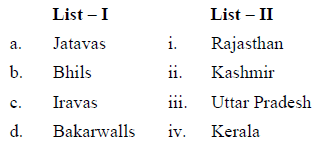

24. Who, among the following, are associated with Indianisation of Sociology ?
(1) G.S. Ghurye, A.K. Saran, D.P. Mukherji
(2) G.S. Ghurye, T.K. Oommen, A.K. Saran
(3) G.S. Ghurye, A.R. Desai, D.P. Mukherji
(4) G.S. Ghurye, T.K. Oommen, A.R. Desai
25. Match List-I with List-II.


26. Technological development and the extent of geographical and social isolation are the parameters used to differentiate tribal communities one from the other. Who said this ?
(1) N.K. Bose
(2) Surajit Sinha
(3) D.P. Mukherji
(4) G.S. Ghurye
27. Of the following who is well known for using subaltern perspective in studying the Indian Society ?
(1) D.P. Mukherji
(2) Y.B. Damle
(3) Gail Omvedt
(4) N.K. Bose
28. Which is the term used by Giddens for the contemporary crisis ?
(1) Manufactured uncertainties
(2) Fluid Society
(3) Imagined nationalism
(4) Closed boundaries
29. The main limitation of structural functional perspective is that it –
(1) is suffering from unreliability.
(2) is not based on empirical evidence.
(3) considers only the static picture currently available at the time of field work.
(4) gives importance to field work.
30. Who coined the concept ‘culture of poverty’ ?
(1) Oscar Lewis
(2) Gunnar Myrdal
(3) M.N. Srinivas
(4) M. Marriott
31. In our country the child labour is actually practiced in :
(1) Service sector in the formal organizations
(2) Formal productive units
(3) Software units
(4) Cottage industries
32. Given below are two statements, one is labelled as Assertion (A) and other as (R) :
Assertion (A) : The Melting Pot thesis does not hold true for the nation building process in India.
Reason (R) : The political unification preceded the cultural integration of the country.
Select the correct answer from the following codes :
Codes :
(1) Both (A) and (R) are correct and (R) is the correct explanation of (A).
(2) Both (A) and (R) are correct, but (R) is not the correct explanation of (A).
(3) (A) is true, but (R) is false.
(4) (A) is false, but (R) is true.
33. Which one among the following is not the cause of ethnonationalism in India ?
(1) The uneven distribution of resources.
(2) The process of democratization.
(3) Mass education.
(4) Empowerment of women.
34. Who among the following has mobilized the poor for the right to information in Rajasthan particularly and other parts of the country as well ?
(1) Mridula Mukherjee
(2) Aruna Roy
(3) Pupul Jayakar
(4) Krishan Bhatia
35. What is the percentage of Delhi’s population living in planned colonies ?
(1) 33.08
(2) 23.7
(3) 55.0
(4) 73.0
36. How many towns are there in India as per census 2011 ?
(1) 7935
(2) 8112
(3) 5161
(4) 7703
37. Given below are two statements, one labelled as Assertion (A) and other as Reason (R).
Assertion (A) : Slum dwellers living in Central part of cities are uprooted and displaced frequently in the name of encroachments.
Reason (R) : Cities’ Central places are more valuable for urban local bodies in the present neo-liberal markets to fetch much revenue.
Select the correct answer from the following codes :
Codes :
(1) Both (A) and (R) are true and (R) is the correct explanation of (A).
(2) Both (A) and (R) are true, but (R) is not the correct explanation of (A).
(3) (A) is true, but (R) is false.
(4) (A) is false, but (R) is true.
38. Given below are two statements, one is labelled as Assertion (A) and other as Reason (R) :
Assertion (A) : As per census 2011, total increase in urban population was more than total increase in rural population.
Reason (R) : There is tremendous increase in the number of census towns.
Select the correct answer from the following codes :
Codes :
(1) Both (A) and (R) are true and (R) is the correct explanation of (A).
(2) Both (A) and (R) are true, but (R) is not the correct explanation of (A).
(3) (A) is true, but (R) is false.
(4) (A) is false, but (R) is true.
39. Who has said that “some of the most powerful American business enterprises were in fact ‘habitual criminals’ ” ?
(1) Hermann Mannheim
(2) E.H. Sutherland
(3) John Mack
(4) Elliot and Merril
40. Modern criminology is concerned to discover ways of :
(1) Reducing crime and delinquency.
(2) Successful treatment for offenders.
(3) Crime detection.
(4) Both (1) and (2)
41. Which of the following is not a form of domestic violence ?
(1) Dowry deaths
(2) Sexual Abuse
(3) Abduction
(4) Wife battering
42. According to R.K. Merton, which path is followed by the drug addicts ?
(1) Ritualism
(2) Frustration
(3) Rejectionism
(4) Retreatism
43. Who among the following attempted to discover the social causes of suicide by relating the rates of suicide in different social groups to the characteristics of the group ?
(1) E.H. Sutherland
(2) E. Durkheim
(3) Max Weber
(4) R.K. Merton
44. In the wake of Globalization Indian economy has –
(1) Reasserted its commitment to socialist path of development.
(2) Reasserted to mixed economic path.
(3) Reasserted the Gandhian model of self sufficiency.
(4) Opened up to economic neo-liberalism
45. Which one of the following is not an objective of ‘Science Policy – 2003’ ?
(1) Accomplishing national strategy and security related objectives by using latest advances in science and technology.
(2) Invite private parties to invest in research and development.
(3) Foster scientific research in Universities and other academic bodies.
(4) Empowerment of women in all science and technology.
46. By connecting countries, globalization has resulted into :
(1) Lesser competition among producers.
(2) Greater competition among producers.
(3) Making a country dependent on others.
(4) No competition among the producers.
47. Among the following who has given six-fold classification of Indian traditions ?
(1) M.N. Srinivas
(2) McKim Marriott
(3) Milton Singer
(4) S.C. Dube
48. Who among the following are the prominent members of little tradition in Indian Society ?
(1) Folk artists
(2) Teachers
(3) Elites
(4) Nobles
49. “Nationalism in India is a product of the material condition created by the British colonialism.” Whose statement is it ?
(1) David E. Apter
(2) R. Bendix
(3) T.K. Oommen
(4) A.R. Desai
50. Who has written/edited the book ‘Peasants and Peasant Societies’ ?
(1) Robert Redfield
(2) T. Shanin
(3) Eric Wolf
(4) Oscar Lewis
51. Match List-I with List-II and select the correct answer from the codes given below the lists.
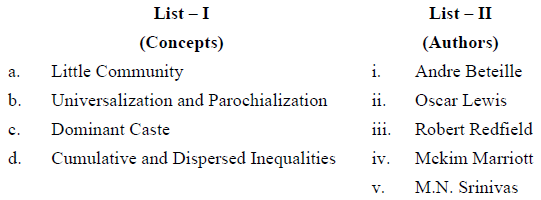
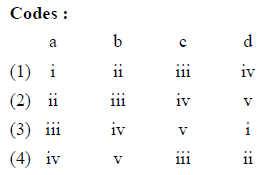
52. From among the following who has studied peasant movements in the Indian context ?
(1) David Hardiman
(2) D.N. Majumdar
(3) D.N. Dhanagare
(4) S.C. Dube
53. Given below are two statements, one is labelled as Assertion (A) and other as Reason (R).
Assertion (A) : By participation in the democratic institutions women are feeling empowered in the rural India.
Reason (R) : The constitutional amendments have ensured participation of women in the democratic institutions of rural life.
Select the correct answer from the codes given below :
Codes :
(1) Both (A) and (R) are true and (R) is the correct explanation of (A).
(2) Both (A) and (R) are true, but (R) is not the correct explanation of (A).
(3) (A) is true, but (R) is false.
(4) (A) is false, but (R) is true.
54. Pauperization means :
a. the process of making people pauper or impoverishing.
b. a state of extreme poverty or destitution.
c. a state of fulfilment of minimum needs.
d. a state of indigence.
Select the correct answer from the codes given below :
(1) a, b and c
(2) b, c and d
(3) a, c and d
(4) b, d and a
55. Who initiated the studies in Industrial Sociology in India after its independence ?
(1) Rangarajan and Ramaswamy
(2) Mehta and Tripathi
(3) Sheth and Mayers
(4) Breman and Das
56. Which among the following is not the essential characteristic of bureaucracy ?
(1) Oral communication
(2) Division of labour
(3) Written rules
(4) Impersonal relations
57. According to Max Weber ‘alienation in a capitalistic system’ refers to
(1) Estrangement with one’s work
(2) Disenchantment of a worker
(3) Freedom from the routine work
(4) Engagement with the work
58. When did the first National Commission on Labour submit its Report on labour problems, both in the organized and unorganized sector ?
(1) 2002
(2) 1969
(3) 1952
(4) 2006
59. Which statement among the following is associated with the understanding of a ‘Postindustrial city’ ?
(1) A city with only a few thousand people living within its borders and characterized by a relatively closed class system and limited mobility.
(2) A city in which global finance and the electronic flow of information dominate the economy.
(3) A city that lacks proper infrastructure and is over crowded with tourists.
(4) A city that is newly established for the governing elite of the country.
60. Given below are two statements, one is labelled as Assertion (A) and other as Reason (R) :
Assertion (A) : Majority of the Coastal States in India are highly urbanized.
Reason (R) : They had early interaction with other countries.
Select the correct answer from the codes give below :
Codes :
(1) Both (A) and (R) are true and (R) is the correct explanation of (A).
(2) Both (A) and (R) are true, but (R) is not the correct explanation of (A).
(3) (A) is true, but (R) is false.
(4) (A) is false, but (R) is true.
61. Human Development Index was developed by
(1) Dr. Manmohan Singh
(2) Dr. Mahbub ul Haq
(3) Dr. Asish Bose
(4) Dr. Montek Singh Ahluwalia
62. Which one is not the indicator of Millinium Development Goals ?
(1) Eradicate extreme Poverty and Hunger
(2) Achieve Universal primary education
(3) Reduce Child Mortality
(4) Shelter for all
63. Who has written the book, ‘Asian Drama’ ?
(1) A.G. Frank
(2) G. Myrdal
(3) Samir Amin
(4) Ashish Nandi
64. Given below are two statements, one is labelled as Assertion (A) and other as Reason (R) :
Assertion (A) : Development is responsible for the uneven development.
Reason (R) : Development always takes place at the cost of backward regions.
Select the correct answer from the following codes :
Codes :
(1) Both (A) and (R) are correct and (R) is the correct explanation of (A).
(2) Both (A) and (R) are correct, but (R) is not the correct explanation of (A).
(3) (A) is true, but (R) is false.
(4) (A) is false, but (R) is true.
65. Which one is not the part of dependency theories of development ?
(1) Centre-Periphery
(2) Under development
(3) Core
(4) Smart City
66. In India the dual report system is being used for reliable estimates of Vital statistics as part of :
(1) Sample Registration System
(2) National Sample Survey
(3) Population Register
(4) National Family Health Survey
67. The slogan “Save planet earth” was generated at :
(1) Rio Earth Summit
(2) Jakarta Summit
(3) Copenhagen Summit
(4) Brazil Summit
68. Who among the following has developed the theory of step migration ?
(1) Ravenstein
(2) D.J. Bogue
(3) E.S. Lee
(4) K. Davis
69. In which year the first phase of the ‘Reproductive and Child Health Project’ was initiated in India ?
(1) 1995
(2) 2000
(3) 2005
(4) 1997
70. Low Birth weight and pregnancy wastage in a given population occur primarily due to :
(1) Insufficient health care
(2) Female illiteracy
(3) Maternal malnutrition
(4) Traditional practices
71. Match List-I with List-II.

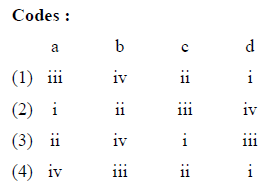
72. Which one of the following gender-related issues, according to the Supreme Court guidelines, formed into an Act in 2013 ?
(1) Dowry deaths
(2) Honour killings
(3) Sexual Harassment at the workplace
(4) Domestic Violence
73. Match the following lists :


74. Which one of the following is not a correct match ?
(Authors) (Books/Articles)
(1) Leela Dube – Matriliny and Islam
(2) K. Saradamoni – Matriliny Transformed
(3) T. Nongbri – Gender and Khasi Family Structure
(4) F. Agnes – Law and Gender Inequality
75. For Whom, ‘patriarchy is no less inflicting than caste’ ?
(1) Self Employed Women’s Associations
(2) Dalit Women’s Organizations
(3) Human Rights Movements
(4) Alliance for Restoration of peace
Latest Govt Job & Exam Updates: